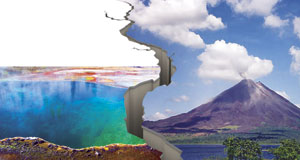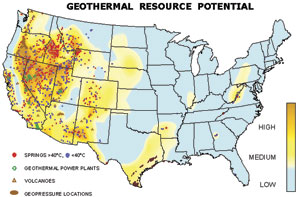BY JUDY ZIMOLA
Metaphysically speaking, the Earth is a potent symbol of power and renewal. When people find it necessary to recharge their psyche, they often speak of “grounding,” – the need to tap the primal force that ignites one’s inner spark and sets the rotors spinning. In the physical world, the earth’s power is beautifully, fearfully tangible, evidenced by volcanoes, earthquakes, and geysers. However, there’s a more controlled, though equally compelling, side to this brutish force. In the folds and rocks of our planet’s crust lies an inexhaustible source of energy; a dynamic store of raw power constantly recharged by the sun, readily accessible and elegantly efficient.
GEOTHERMAL ENERGY uses the heat (“thermal”) that is contained inside the Earth (“geo”) to warm or cool air and water. Using geothermal energy goes back as far as, well, since there’s been a geo. Civilizations utilized energy stored below the surface of our planet for heating, medicinal purposes, bathing and cooking. Animals, both scaled and furry, instinctively burrow into the Earth, where the temperature is relatively stable compared to the air temperature, to get shelter from winter’s cold and summer’s heat.
Geysers and volcanoes are explosive examples of the power that lies beneath our feet, with water hot enough to power the turbines that run a factory or light a town. But quietly residing in the rocks and soil under the Earth’s surface are geothermal reservoirs of low to moderate heat that can be tapped for direct-use geothermal power – low-temperature energy taken directly from the Earth and requiring no power plants. Popular belief has led many to assume that Arizona’s ground temperatures aren’t suitable for direct-use geothermal, especially for cooling.
To be blunt, they’re wrong.
“Direct use geothermal works perfectly in Arizona,” said Glenn Myers, co-owner of Verde Sol Air in Clarkdale. “A geothermal system is a heat pump that doesn’t use unstable air temperatures, but stable ground temperatures. Arizona’s ground temperature is a constant 55 to 58 degrees Fahrenheit, perfect for heating and cooling.”
Direct-use geothermal heating and cooling units work this way: a geothermal heat pump (GHP) takes that stable Earth temperature that lives just a few feet below the surface and transfers that heat into a circulating liquid that courses through pipes buried in a continuous loop. This heat is then is transferred into the building. To cool a building, the fluid in the pipes absorbs heat from the building – similar to the way coils pick up heat from a refrigerator’s interior – and dispels it into the Earth.
Glenn and his brother, Verde Sol Air co-founder David Myers, are eager to talk about how GHPs “last twice as long as central air [and] it burns zero fossil fuels.” Additionally, it’s more efficient than the best central air systems and “you can transfer as much heat with one gallon of water as you can with about 4,000 cubic feet of air.”

For all its attributes, however, geothermal energy has languished by the punchbowl while its popular cousin, solar power, gets all the dances. If geothermal energy is so great, why the delay? “There’s just not a lot of people chasing it,” said Jim Witcher, geothermal expert and principal of Las Cruces, New Mexico-based Jim Witcher and Associates.
“Simply put, people are aware of the sun and the wind. They’re above us, all around us, so it’s an easy concept to understand,” Witcher said. “Wind and solar power receive a lot of publicity [and] there’s legislation that favors wind and solar installations in the form of good tax breaks and incentives.”
“But geothermal has a lot of advantages,” he said. “Utility companies actually prefer geothermal because of baseload power, which means it produces electricity 24/7. There are simply no power outages, unlike solar or wind, which can have spikes in power.”
According to Witcher and the U.S. National Renewable Energy Laboratory, the capacity factors of geothermal plants are comparable with those of coal and nuclear power.
Witcher is well-versed in geothermal energy’s commercial applications. “Direct use can be applied to anything: raising fish – warm water is used for shrimp and tilapia farms; vegetable farms – a lot of the irrigation that’s done pumps warm water. Spas use it, of course. You can dry wood, brick, adobe, anything that requires low-grade heat for agriculture and industrial process. It can even be used for mining.”
He suggested geothermal heat could speed up chemical and kinetic reactions, such as improving the speed and efficiency of copper leaching.
“The new schools are beginning to put in geothermal systems and quite frankly, every new home should have a geothermal pump,” Witcher insisted. “You’ll hear people say the soil is too rocky or too hot in Arizona, but that’s not true. You just dig a deeper hole for the coils.”
Because the Earth’s temperature is constant, these types of heating and cooling systems are less stressed than conventional central heat and air systems, translating to conserved energy. Homeowners can reasonably anticipate a hefty monthly savings in the neighborhood of 25 to 50 percent of current utility bills, depending on variables like climate and soil conditions and the amount of financing and incentives received.
Clarkdale resident Nick Hunseder, a forward-thinking homeowner and a self-described techno-geek with a passion for conserving energy, has completely embraced green technology for his home. He has installed solar panels, xeriscaped, and recently replaced his attic insulation with semi-rigid foam to seal all energy leaks. Currently he’s in the middle of installing a geothermal system. “I installed solar first for the immediate reduction in electrical. After that, it made more sense to me to reduce as much energy consumption as I could,” Hunseder said.
If thousands of homes installed a geothermal unit, the need for oil imports would decrease exponentially.
Not only will Hunseder reduce his carbon footprint, he’ll reduce his physical footprint too, or at least his home’s footprint. He rattles off a list of appliances soon to get the energy pink slip: “Two conventional AC units, two gas-fired furnaces, two evaporative coolers and a gas-fired hot water heater will all be replaced by one geothermal unit.”
He already has a surplus of electricity saved for the hottest summer months. “I’m sitting on about 1,600 kilowatt-hours of credit,” he said with pride. “I anticipate a surplus 12 months out of the year once the geothermal system is operating.”
Hunseder laughs off the suggestion that his home is a sort of living laboratory, and puts a much more pragmatic spin on his earth-friendly improvements. “It’ll take about eight years for the paybacks in these improvements to kick in,” Hunseder said. “After that, my wife and I won’t have to worry about utility bills as we start to think about slowing down work. If we’re going to replace things like the heating and air, we’re going to go proactive rather than reactive.”
Going proactive with geothermal energy is the Town of Clarkdale’s newly formed Sustainable Clarkdale initiative, helmed by Clarkdale Sustainability Park project manager, Jodie Filardo. “The town received a grant for replacing the conventional heating system in the historic Clark Memorial Clubhouse, and we wanted to bring forward a solution that took advantage of new opportunities,” Filardo said.
A civic gem, the mission-style Clark Memorial Clubhouse was built in 1926 and is listed in the National Register of Historic Places. Practically all events requiring a venue find it at the clubhouse. The antiquated heating and cooling system, however, restricted use of the building to months when the weather was most temperate – a relatively narrow window for a high desert state. A geothermal unit that regulates temperatures in the men’s lounge, women’s lounge and reading room replaced the building’s conventional system.
“It’s worked out fabulously,” Filardo said. “We used to be restricted to only four months of operations, and now we can use [the clubhouse] 12 months out of the year – and it’s made a huge positive impact on the operation of our town.” The new system was displayed during Sustainable Clarkdale’s “Sustainability in Our Own Backyard” event in May, where visitors could observe the compact system, ask questions, and most importantly, experience the comfortable environment created by the geothermal installation.
Filardo explained that installing the unit wasn’t just about showcasing Clarkdale’s new technology. “The goal for Sustainable Clarkdale is to be viewed not just as a model of green practices, but as a template for Clarkdale‘s future success,” she said. “And the geothermal system is a good example of green technology that’s accessible and appropriate for both homes and businesses. Geothermal is the perfect technology to address the past and future.”
As more people become aware of direct-use geothermal’s off-the-charts efficiency ratings, quick return on investment, infinite renewability, and increased oil independence, it seems only a matter of time before geothermal energy receives more attention and understanding. True believers like Nick Hunseder will be spreading the word about savings and foresight for generations to come.
- SOURCES
- http://www.archiplanet.org/wiki/Clark_Memorial_Clubhouse, Arizona Water Resource, September – October 2000, volume 9, Number 2
- http://clarkdalesustainabilitypark.org/, Environmental Protection Agency, Space Conditioning: The Next Frontier, Office of Air and Radiation, 430-R-93-004 (4/93)
- http://geo-energy.org/Basics.aspx, Geothermal Energy’s Potential By Ken Silverstein, Editor-in-Chief, EnergyBiz Insider , August, 2008
- http://www.geothermal.nau.edu/comments040407.pdf
- http://www.ucsusa.org/






